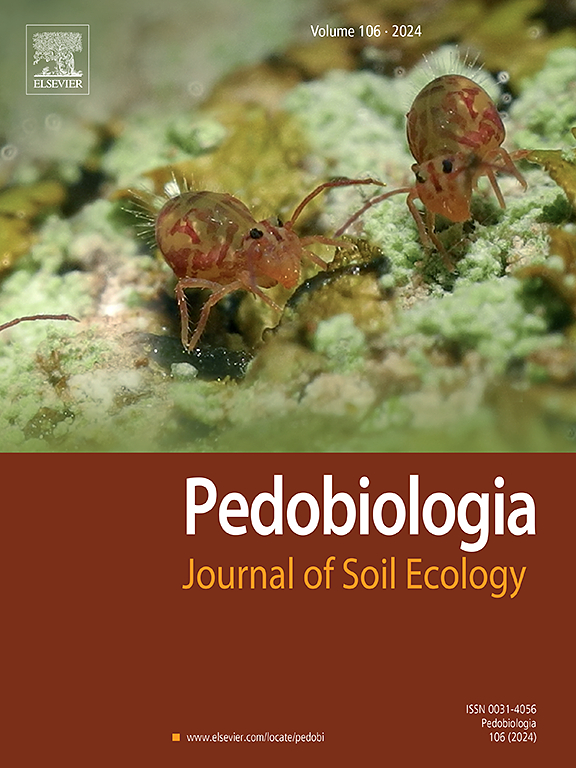Inter- and intra-site variation of microarthropod communities in urban parks
IF 2
3区 农林科学
Q3 ECOLOGY
引用次数: 0
Abstract
Urban parks are one of the most represented green spaces in cities and can support biodiversity. However, most of the studies demonstrating the role of urban biodiversity do not take into account soil biodiversity, which represents at least ¼ of the world's taxonomic diversity. Among these soil organisms, microarthropods are recognised bioindicators because of their role in soil functioning but also because of their high abundance and sensitivity to a variety of environmental and anthropogenic factors. With high heterogeneity due to soil, management or localisation, nothing looks less like a park than another park. In this study, our aim is rather to understand how soil biodiversity is affected by the spatial configuration of the parks. To do this, we studied inter- and intra-park variation in microarthropod communities using taxonomic and functional approaches based on traits. Our results show communities dominated by Acari, with high abundances of Collembola but low specific richness. Inter-park variations were recorded for the species richness and functional composition of Collembola, Oribatidae abundance, texture and metal levels. That may be linked to the age of the sites in relation with soil physicochemical parameters. Intra-park variations were also observed, particularly for biodiversity indices, which could be explained by the fragmentation of the site and patch size. Despite their small size, soil organisms should be considered in park studies and design (configuration and connectivity). Indeed, understanding the distribution patterns of these organisms is important for improving the role of parks within a functional green and brown urban network.
城市公园微节肢动物群落的点间和点内变异
城市公园是城市中最具代表性的绿色空间之一,可以支持生物多样性。然而,大多数证明城市生物多样性作用的研究都没有考虑到土壤生物多样性,而土壤生物多样性至少占世界分类多样性的四分之一。在这些土壤生物中,微节肢动物是公认的生物指标,因为它们在土壤功能中的作用,也因为它们的高丰度和对各种环境和人为因素的敏感性。由于土壤、管理或本地化的高度异质性,没有什么比另一个公园更不像公园了。在本研究中,我们的目的是了解土壤生物多样性如何受到公园空间配置的影响。为此,我们采用基于性状的分类学和功能学方法研究了小节肢动物群落间和园内的变异。结果表明,群落以蜱螨为主,弹尾虫丰度高,比丰富度低。在不同的公园内,弹虫的种类丰富度和功能组成、甲螨的丰度、质地和金属含量均有不同的变化。这可能与地点的年龄与土壤理化参数有关。公园内的生物多样性指数也发生了变化,这可以用场地的破碎化和斑块大小来解释。尽管土壤生物体积小,但在公园研究和设计(配置和连通性)中应考虑土壤生物。事实上,了解这些生物的分布模式对于改善公园在绿色和棕色城市网络中的作用非常重要。
本文章由计算机程序翻译,如有差异,请以英文原文为准。
求助全文
约1分钟内获得全文
求助全文
来源期刊

Pedobiologia
环境科学-生态学
CiteScore
4.20
自引率
8.70%
发文量
38
审稿时长
64 days
期刊介绍:
Pedobiologia publishes peer reviewed articles describing original work in the field of soil ecology, which includes the study of soil organisms and their interactions with factors in their biotic and abiotic environments.
Analysis of biological structures, interactions, functions, and processes in soil is fundamental for understanding the dynamical nature of terrestrial ecosystems, a prerequisite for appropriate soil management. The scope of this journal consists of fundamental and applied aspects of soil ecology; key focal points include interactions among organisms in soil, organismal controls on soil processes, causes and consequences of soil biodiversity, and aboveground-belowground interactions.
We publish:
original research that tests clearly defined hypotheses addressing topics of current interest in soil ecology (including studies demonstrating nonsignificant effects);
descriptions of novel methodological approaches, or evaluations of current approaches, that address a clear need in soil ecology research;
innovative syntheses of the soil ecology literature, including metaanalyses, topical in depth reviews and short opinion/perspective pieces, and descriptions of original conceptual frameworks; and
short notes reporting novel observations of ecological significance.
 求助内容:
求助内容: 应助结果提醒方式:
应助结果提醒方式:


